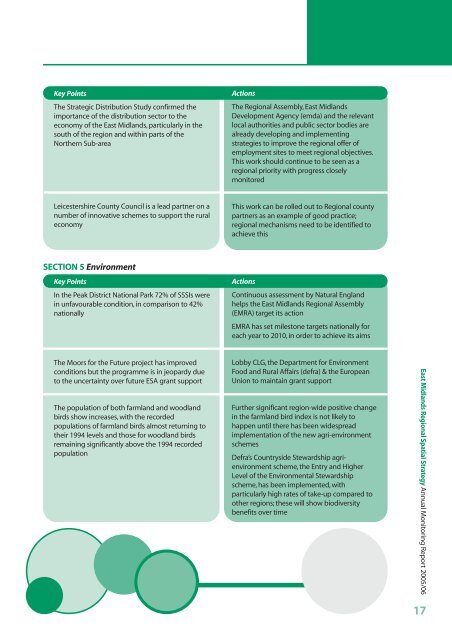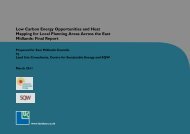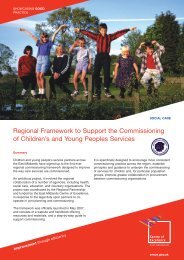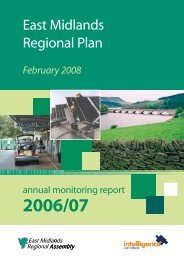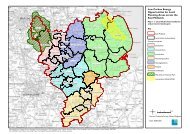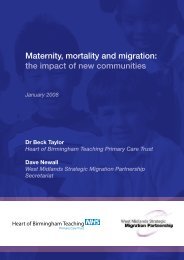East Midlands Regional Spatial Strategy 2005/06
East Midlands Regional Spatial Strategy 2005/06
East Midlands Regional Spatial Strategy 2005/06
Create successful ePaper yourself
Turn your PDF publications into a flip-book with our unique Google optimized e-Paper software.
Key Points<br />
The Strategic Distribution Study confirmed the<br />
importance of the distribution sector to the<br />
economy of the <strong>East</strong> <strong>Midlands</strong>, particularly in the<br />
south of the region and within parts of the<br />
Northern Sub-area<br />
Actions<br />
The <strong>Regional</strong> Assembly, <strong>East</strong> <strong>Midlands</strong><br />
Development Agency (emda) and the relevant<br />
local authorities and public sector bodies are<br />
already developing and implementing<br />
strategies to improve the regional offer of<br />
employment sites to meet regional objectives.<br />
This work should continue to be seen as a<br />
regional priority with progress closely<br />
monitored<br />
Leicestershire County Council is a lead partner on a<br />
number of innovative schemes to support the rural<br />
economy<br />
This work can be rolled out to <strong>Regional</strong> county<br />
partners as an example of good practice;<br />
regional mechanisms need to be identified to<br />
achieve this<br />
SECTION 5 Environment<br />
Key Points<br />
In the Peak District National Park 72% of SSSIs were<br />
in unfavourable condition, in comparison to 42%<br />
nationally<br />
Actions<br />
Continuous assessment by Natural England<br />
helps the <strong>East</strong> <strong>Midlands</strong> <strong>Regional</strong> Assembly<br />
(EMRA) target its action<br />
EMRA has set milestone targets nationally for<br />
each year to 2010, in order to achieve its aims<br />
The Moors for the Future project has improved<br />
conditions but the programme is in jeopardy due<br />
to the uncertainty over future ESA grant support<br />
The population of both farmland and woodland<br />
birds show increases, with the recorded<br />
populations of farmland birds almost returning to<br />
their 1994 levels and those for woodland birds<br />
remaining significantly above the 1994 recorded<br />
population<br />
Lobby CLG, the Department for Environment<br />
Food and Rural Affairs (defra) & the European<br />
Union to maintain grant support<br />
Further significant region-wide positive change<br />
in the farmland bird index is not likely to<br />
happen until there has been widespread<br />
implementation of the new agri-environment<br />
schemes<br />
Defra’s Countryside Stewardship agrienvironment<br />
scheme, the Entry and Higher<br />
Level of the Environmental Stewardship<br />
scheme, has been implemented, with<br />
particularly high rates of take-up compared to<br />
other regions; these will show biodiversity<br />
benefits over time<br />
<strong>East</strong> <strong>Midlands</strong> <strong>Regional</strong> <strong>Spatial</strong> <strong>Strategy</strong> Annual Monitoring Report <strong>2005</strong>/<strong>06</strong><br />
17


